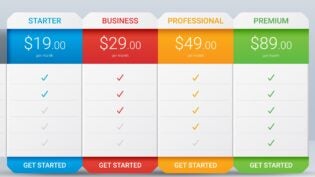
No sales business model is “forever.” As our markets change, as our customers change, as our own business strategies change, there is a necessity to reassess our sales business models and go to market strategies.
Unfortunately, too many companies ignore these transitions. They stay stuck with one model, working harder and harder, failing to produce the results, but failing to recognize the characteristics of their markets have changed—requiring a need to change the sales business model.
Or they may have chosen the wrong business model in the first place.
We’re all familiar with the classic “S curves” of growth. Some of this was popularized (at least from a sales/marketing point of view by Geoffrey Moores’ work. These can give us some insight about the sales business model most appropriate for the business. Let me walk through some.
The sales business model for each of these stages is different. The characteristics of customers in each segment are different. The sales business model is different. How we engage innovators, how we create value, how we help them navigate their buying process is different from what we must do for early adopters, early/late majority, or laggards.
Yet if we apply a sales business model optimized for one segment to others, we will fail.
Let’s walk through some of the implications of these:
- Innovators: If our ICP is the innovator category, the sales model is very different than other categories. By definition, it’s a relatively small market. These customers are likely to contribute to the development of our solutions and the very early development of the market. “Selling” in this market tends to look more like developing strategic alliances, development partnerships, and so forth. It requires deep expertise and focuses on customers that are willing to experiment, learn, co-develop. They have a high risk profile—they recognize some of these “experiments” may not work. Typically, they will isolate the “experiment” to a small part of their business. Our “selling” is very focused—probably led by our CEO and other top managers. We are focused on pinpointing these innovators and approaching them at a very strategic level. We have no “sales process,” we have limited to no marketing, we can’t staff the traditional sales roles, because we and the target customers are trying to figure out just what our solution is, what our value proposition is, and who our mainstream customers are likely to be. The big challenge is there is little in our sales approach to these customers that is adaptable and meaningful to scaling our approach to selling.
- As we move into the early adopters, we are still in a rapid learning and adaptation position. We are refining our ICP, we are still discovering and refining our value proposition, we are just beginning to develop our sales process, and refining our “go to market strategies.” Early in this stage, we are experimenting, learning, adapting, figuring out what works and what doesn’t work. We start to look for the “patterns” that drive success and what it takes to replicate and scale those. We are less concerned about “efficiency,” more concerned about figuring out what works. Our win rates may be low, but increasing as we move through this stage. Our sales cycle may initially be long, but decreasing as we move toward the early majority stage. The sales people have to be more mature in each role. They will be the people figuring out the right approaches, refining them and teaching them to new people as the organization grows. The people who focus on day to day execution early in this stage probably end up as the managers and leaders as we exit this stage. As we move to exiting this stage, we have locked in our ICP, our messaging, our sales process, the organizational structure, roles/responsibilities, our value propositions. In this stage, we are focusing on sales effectiveness. As we move to exiting this stage, we add a focus on efficiency, which enables us to scale.
- When we move into the early majority, we are rapidly scaling. We have the “formula for success,” now we are trying to replicate and scale this a quickly as possible. We are optimizing our overall operations. Increasingly, we are concerned about efficiency and cost of selling. In some sense our sales efforts may be easier, because the customers/prospects are increasingly more comfortable with the solution category. At the same time, this is where we will see more competition, so we are likely to see greater price pressure as we sell.
- As we reach the peak and start moving into the late majority, there’s a huge shift in our selling approach. The solution category is getting commoditized. The perceived risks or the solution are low and very well known. The sale may be moving more toward a transactional sale. The primary focus becomes efficiency, reducing the cost of selling/customer acquisition. We may no longer be able to afford our old selling model, we may have to leverage other channels much more than in the past, perhaps moving much to web based efforts, channel partners, Direct, field based sales may become unaffordable, We look to higher levels of efficiency and much lower cost in our inside efforts. The important thing to recognize as we are moving from the early adopters to the later adopters is it probably means a huge shift in everything we do and how we sell. If we don’t recognize that shift and adapt quickly, we quickly become uncompetitive and our sales organizations are unaffordable.
- As we move into the laggards, it’s a very small market, it may be a less profitable market. We need to focus on the lowest cost of selling possible. Some may choose to abandon these markets—the margins for deals may be unacceptable.
Most of this is pretty obvious, but there start to be some complications that start to overlay this—these become sales effectiveness/efficiency/performance killers.
Let’s walk through some of these:
- Our marketing changes depending on where we are in the cycle. How, who, what we do to engage customers who are innovators is completely different from engaging laggards. Unless we change our approaches based on the target segment, then we won’t be as effective as we should be.
- Our selling process is different for each stage in the process. How we engage innovators and move them through the buying process is different than what we need to do with early adopters, the early majority, and so on. If we aren’t changing our sales process as we move through this maturity cycle, we will not be engaging the customers in those stages in the best way possible.
- Our value proposition and the way we create value changes depending on which stage we are in. The value proposition for early adopters is different than the early majority. There may be some overlaps, but there will be some important differences. For example a value proposition focused on low risk is probably important to early, late majority and certainly to laggards. But it is likely to be meaningless to innovators.
- Each of these stages has different implications for the skills, competencies, capabilities of our sales people. We may need very deep product/solution, problem, market knowledge in some segments, and less in segments that are more mature.
- If we sell multiple solutions, some solutions categories may be in very different stages of the solution/market maturity. For example if we are selling ERP solutions, the market is very mature. As we add AI enabled solutions, the solution category is much less mature. Who we target, how we engage each, the skills for success may be very different.
I’ll stop here, I think you get the idea. It’s really critical to understand the maturity the solutions category/customers we are trying to reach and we develop sales business models optimized to those segments.













